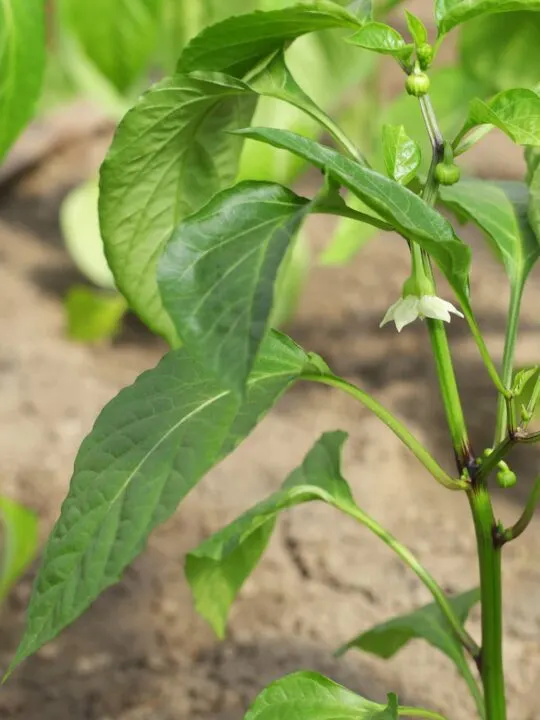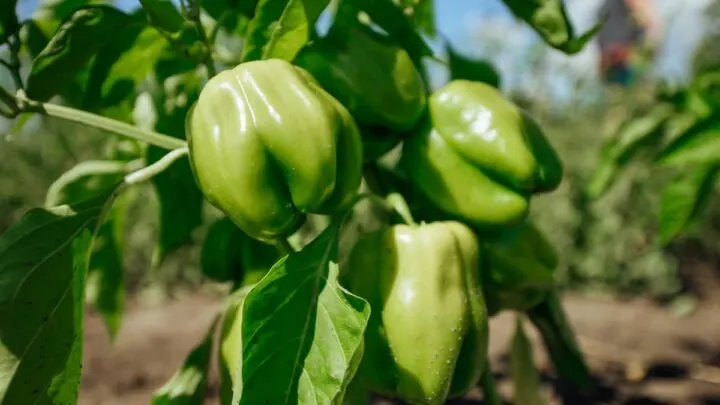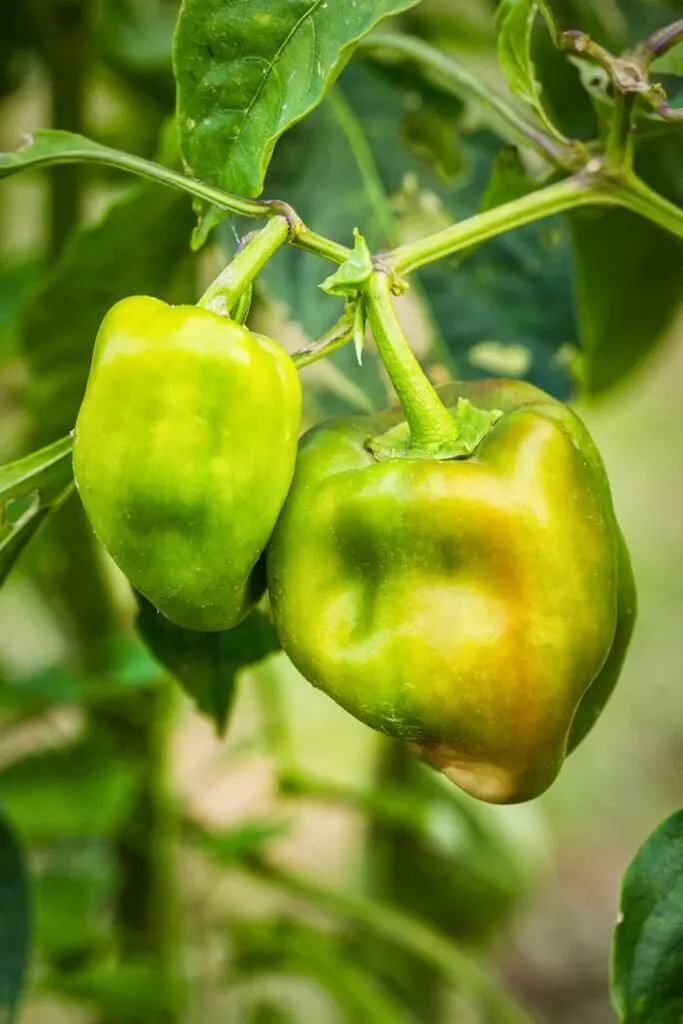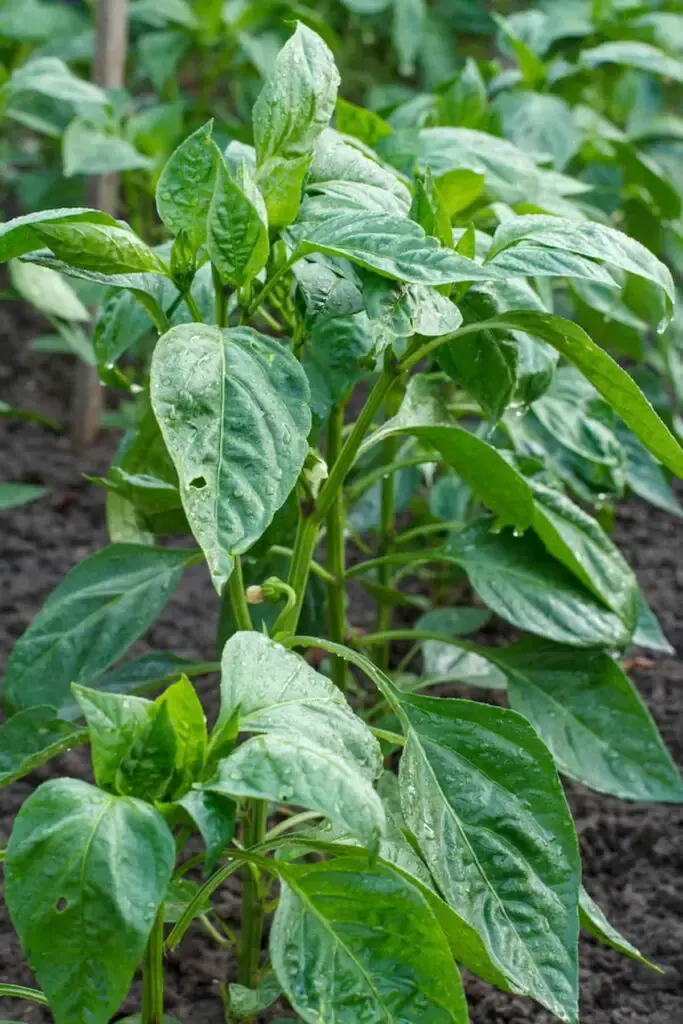Pepper plants are among the easiest and most popular plants to grow in everyone’s gardens. They are generally straightforward to grow, and require little maintenance. Although peppers aren’t too needy, some problems can occur. You may notice your pepper plant leaves turning upside down.
Pepper leaves turn upside down when the plant has something in its environment that is stressing it out. This includes transplant shock, lack of watering, and herbicide damage.
Below, we will be talking about why pepper leaves turn upside down. We will discuss how we can fix it and how the yield may be affected. Keep reading!

Why Do Pepper Leaves Turn Upside Down?
Environmental stressors often cause plant leaves to turn upside down. The plant may face other issues like diseases, pests, or water problems. Let’s go into detail.
Weather
Weather is one of the main reasons pepper plant leaves will turn upside down. Although peppers are a warm season vegetable, they still have a cut-off point. Weather above 85-90 degrees can be very hot for peppers and cause their leaves to curl. Leaves curl when the weather is hot because the plant is going into survival mode. The lead curl is the plant trying to retain as much moisture as possible while reducing exposure to the sun.
Transplant Shock
If you have recently transplanted your pepper plants outdoors, and the leaves have started to curl, this may be your problem. Transplant shock can happen to transplanted plants moved into different environments. The leaves curl as the plant tries to acclimate to its new home. This will especially happen to smaller seedlings, as they are slightly weaker than a more established plant.

Too Much or Too Little Water
Too much or too little water is one of the easiest mistakes in a garden. It can be hard to determine how much water pepper plants need and if they are getting too much or not enough. Pepper plant leaves will turn upside down when there is too much water because oxygen is very hard to get to the rest of the plant. The plant is essentially drowning.
On the opposite end of drowning, pepper plant leaves will also turn upside down when they do not have enough water. However, this is more of a wilted look because they do not have water to sustain themselves.
Lack of or Too Many Nutrients
Pepper plants need the proper nutrients to thrive and grow like all living things. A plant that lacks nutrients will not have the energy to keep its leaves turned the proper way, and the leaves will eventually start to look depleted and turn upside down.
On the other hand, a plant that has too many nutrients will not know what to do with all the extra supplies. This causes the plant to panic, and the leaves will start to curl.

Disease
Diseases will commonly cause pepper plant leaves to turn inside down. As the disease takes over the plant, the plant gets depleted, leaving the leaves to wilt and eventually die. Diseases like blight, bacterial wilt, and mosaic virus are all examples of diseases that cause leaf curl.
Pests
Several pests attack plants. They suck the nutrients out of the leaves and stems of the plants, and one of the most common symptoms of this pest damage is leaf curl. Aphids, thrips, and mites are all examples of bugs that cause this type of damage.
Herbicide Damage
Herbicide damage can happen to any plant. It can also happen to your garden even if you do not use herbicide. If your neighbor uses herbicide, it can travel through the wind and get onto your plants. Herbicide damage can happen when herbicide has been applied too strongly.
Plants can only take so much herbicide, and if there is too much in the air, their leaves will get burned by the herbicide, thus looking like they are turning upside down.

How To Fix Pepper Plants Upside Down Leaves
In most cases, you can resolve the leaf curling issue as long as you catch the issue quickly.
Weather
Unfortunately, there isn’t much we can do to control the weather. The best thing to do is to prepare and plant at the right time. Pepper plants are warm-weather plants and can be planted three weeks after the last frost.
If you live in an area that gets very warm, you can start your plants indoors, then transplant them outdoors as soon as possible. If you live in an area with a more mild summer, wait to plant them outside until the weather is consistently 70 or above.
If you are getting a heat wave, with temperatures above 95 for more than a few days, try putting a shade cloth up over your pepper plants, so try and block out the sun during the hottest parts of the day to avoid wilt and sunburn.
Transplant Shock
Transplant shock is the easiest problem because it will go away independently. Once you plant your plants outside, give them a little water; all you have to do is wait. Transplant shock shouldn’t last more than a week; if it does, your plants may have a different issue.
Water
The best way to ensure that your pepper plants get the proper amount of water is to have your plants on a good schedule. Pepper plants need about 1 inch of water a week. To maintain this level, it is best to water your plants in mild temperatures every 2-3 days; if it is extremely hot outside, water every day.
If the leaves are curling because of too much water, you must let your plant dry before the next water. If your plant does not have enough water, you must water it immediately. Your pepper plant leaves should return to normal after that.

Nutrients
If a pepper plant lacks nutrients, you will notice discoloring, wilting, and drying up, apart from the leaves turning upside down. The same may happen if the is getting too many nutrients. If the plant is getting too many nutrients, you must stop all feeds and water frequently and let any build-up of nutrients wash out for a few weeks.
The best way to ensure your plants start with a good amount of nutrients is to plant your plants in strong soil—pepper plants, like tomatoes and cucumbers, like a well-balanced fertilizer.
Mix a quality, well-balanced, slow-releasing fertilizer with an NPK of 10-10-10 in with your potting soil to plant your plants. This way, they are getting a slow release of nutrients they need. To boost their nutrient intake, give them liquid feeds. Different stages require different nutrients.
| Stages of Plant | Nutrients Needed |
| Seedling | Phosphorus- Promotes strong root growth |
| Growing | Nitrogen- Helps plants capture sunlight, boosts growth, keeps plants green |
| Fowering | Potassium- Helps plant with the movement and conversion of sugars and waters, making fruit juicer and sweeter |
Disease
Unfortunately, there is no cure for all three diseases mentioned (bacterial wilt, blight, and mosaic virus). The only option is to immediately remove the affected plants and burn them or throw them in the garbage. Never compost diseased plants, as the disease can spread through the soil.
Prevention is key in this case. Ensure you get seeds from a trusted source, rotate your crops, and use quality soil.

Pests
Aphids, thrips, and mites are all rather annoying bugs; however, if they are caught early, and there aren’t too many of them attacking yet, they can get rid of them. If you do not remove them quickly, they will take over your garden, and your yields will be greatly affected.
Diatomaceous earth works wonders for all three types of pests. Sprinkling some around your garden is a great prevention and will help eliminate them.
You can also spray your plants with neem oil. Aphids and thrips respond well to being blasted with water. They will leave your plants immediately; however, you must keep the diatomaceous earth around your plants, so they will not return.
Herbicide Damage
Herbicide damage can harm plants if they receive a very high dose. You can only remove the affected leaves or fruit as soon as they are affected. If it doesn’t keep happening, the plant should be fine, and the fruit will be fine to consume.
If it wasn’t you who sprayed the herbicide, ask your neighbors to kindly use a different product. If you used it on your lawn, perhaps plant your plants in a different area, or stop using the herbicide while you have vegetables around.
Final Thoughts
Pepper plant leaves turning upside down can be a stressful thing. However, as long as you figure out what is causing the damage, you can hopefully fix the issue. Who knows, it could be something as easy as watering your plants more often or giving them a feeding. Happy gardening!

Hi there, my name is Allie and welcome to my blog; GareningWithAllie!
Much of what you see written here is just our personal experiences with gardening. Along with the content I write here, there is also a unique collection of gardening topics covered by some of our close friends. I hope you find everything you read here to be helpful, informative, and something that can make your gardening journey the most lovely experience ever! With that said, Happy Gardening!
